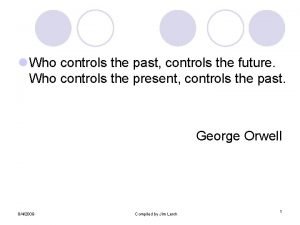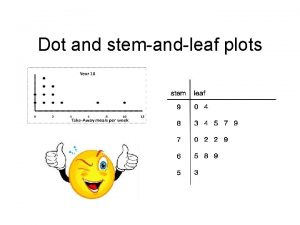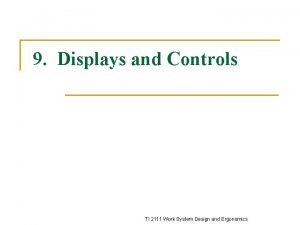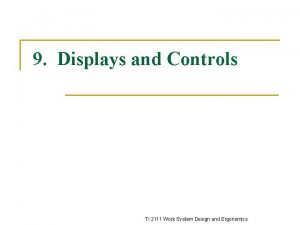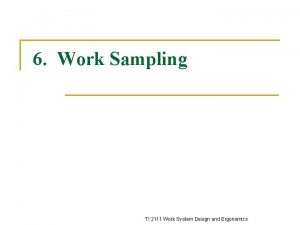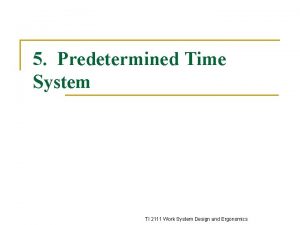9 Displays and Controls TI 2111 Work System







- Slides: 7

9. Displays and Controls TI 2111 Work System Design and Ergonomics

Displays n Purpose of Displays—convey information about a certain entity in our environment or surrounding q Visual Displays—display information to the sight sense n n Conspicuous (attn getting) Legible (easy to see and detect) Understandable (tell you state of the entity or required action to take) Main problem: this sense is overloaded TI 2111 Work System Design and Ergonomics

Visual Displays n Quantitative n Qualitative n Check Reading n Situation awareness TI 2111 Work System Design and Ergonomics

Design Principals n Quantitative displays q q n Qualitative displays q q q n Fixed scale with a moving pointer is preferred is not digital (speedometer), more attn getting, allows you to see a trend in performance or in the data Linear scale is better when presenting information that must be interpreted Use color to enhance meanings Use shape coding to enhance meaning Use zone coding to enhance meaning Check reading and situation awareness q q Design to ensure there is a distinct difference btwn the normal/abnormal states Use signal lights to complement the display n n q n n Flashing lights for hazards Use a continuous light in emergencies Use auditory signals to complement the display For all, the display type should be chosen based on the task New displays should be tested and evaluated TI 2111 Work System Design and Ergonomics

Controls - Compatibility n n n What is compatibility? Degree to which relationships are consistent with expectations q In Ergonomics, typically we are concerned with the relationship between the stimuli and response of controls Compatible Design q Facilitates learning and retention q Reduces errors q Decreases reaction time q Increases satisfaction Types of compatibility q Spatial, movement, operator oriented principals TI 2111 Work System Design and Ergonomics

Spatial Compatibility n Spatial Compatibility (relative placement of the control to the display q Physical Similarity n n q Design to enforce the relationship between the physical features of the control and the mode of operation Example: levers for vertical displays, rotary knobs for rotary displays, etc. Proximity n Closeness, best if the display asso with a control is directly above the control TI 2111 Work System Design and Ergonomics

Movement Compatibility n n n Movement of the control device to follow the movement of the display Movement of a control device to control the display Movement of a control device that produces a specific response Movement of display indication without related response Population stereotypes q q Clockwise results in an increase Up is on Increase is to the right Forward is faster TI 2111 Work System Design and Ergonomics



